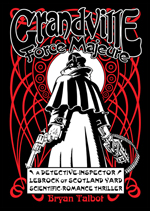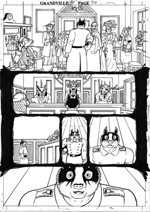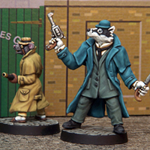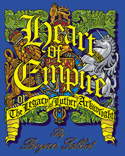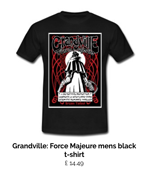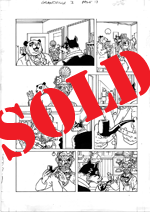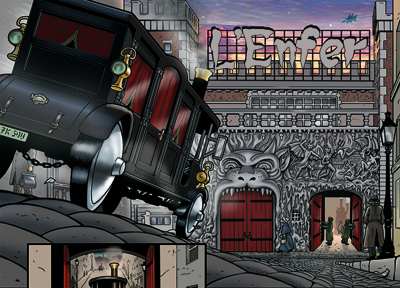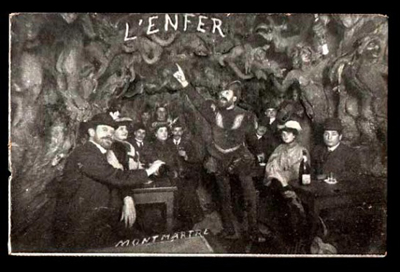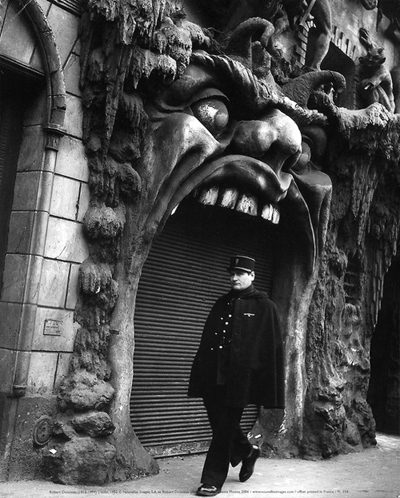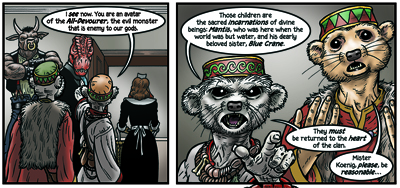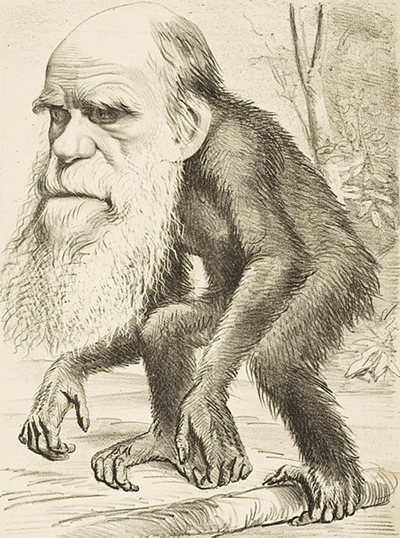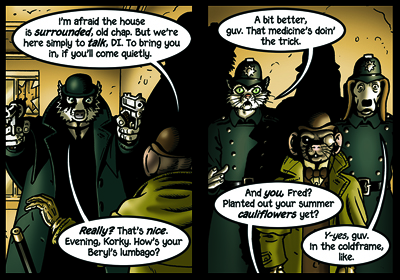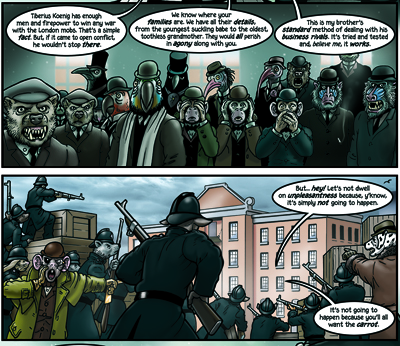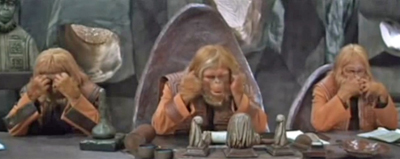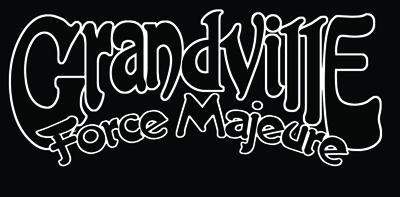
Grandville Force Majeure
annotations - batch 6
This is similar in concept to the Directors Cut of Heart of Empire that Bryan and myself created: it is an attempt to answer the eternal "where do you get your ideas from?" question, and a way to showcase the influences and images that went into the creation of Grandville.
We are publishing updates to this page every Sunday and we will cover the entire Grandville series: we have already completed the annotations for Grandville, Grandville Mon Amour, Grandville Bête Noire and Grandville Noël - and in case you missed them, check out the first batch of Grandville Force Majeure annotations.
Start reading the Grandville Force Majeure annotations below, or jump straight to page 80, page 81, page 82, page 84, page 85, page 91, page 94, page 96, page 97 and page 98.
Page 80
Panel 1
“Farters Parters”: I’m almost certain that this name comes from an episode of Blackadder, arguably the best TV comedy series ever made, but, again, memory fails me. Please enlighten me if you know via the site’s Twitter feed.
Panel 5
“Robert’s your pater’s male sibling”: A U.K. expression to mean “there you go”, “it’s sorted”, “it will be done” etc. is “Bob’s your uncle”. I think this posh version is also from P.G.Wodehouse.
“Jenny” is a wren. Jenny Wren is the nickname of the character Fanny Cleaver in Charles Dicken’s Our Mutual Friend (1864/1865), but is predated in medieval nursery rhymes, one of which is quoted in Shakespeare’s The Merry Wives of Windsor (1602).
Page 81
Panel 6
“Roger the Bull”: “Rodgering” is a term that used to be used by U.K. farmers to describe the mating of a cow with a stud bull, but seems to have since gone into common parlance to mean rough sex.
Page 82
The Hell Club: Koenig’s nightclub is a fantasy version of the real Le Cabaret de l’Enfer (“The Hell Cabaret”), founded in the late 19th century in Montmartre. The waiters dressed as devils and the drinks had satanic names.
The proprietor, one Antonin Alexander, also owned another nightclub next door - Ciel (“Heaven”). L’Enfer existed as late as the early 1950s, when I think this rather amusing photo was taken.
Page 84
Panel 1
The nurse is a frilled lizard. She only raises her frill when she smashes LeBrock on the head on page 137.
Panel 4
“I could dash their brains out right now…”:
“I have given suck, and know how tender tis’ to love the babe that milks me: I would, while it was smiling in my face, Have pluck’d my nipple from his boneless gums, And dash’d the brains out, had I sworn As you have done to.”
Macbeth, Act 1, scene 7
William Shakespeare
Panel 6
Pickaninny: an old-fashioned racial slur, once used in the Southern American States to refer to the children of African slaves, and still used by some aging racists to describe any dark-skinned children.
Page 85
Meerkats come from the Kalahari Desert in Botswana, hence the name of the gang, and really do live in extended family groups, called “clans”. The gang’s belief system, as touched on here, is based on the religion of the Kalahari Bushmen, the oldest surviving cultural group in the world, genetically very close to the original inhabitants of Africa, the first homo sapiens. Like many others all around the world, their creation myth involves a great flood that covers the earth. Mantis is their supreme being and his beloved sister is Blue Crane. The All-Devourer is a devil archetype, an evil monster.
Panel 5
In the world of Grandville, Darwin was a chimp, often caricatured as such in real life.
Page 91
We’ve already met Korky the Cat (see page 78, panel 1 annotations). Beryl the Peril was another character in one of The Dandy’s sister comics, The Topper. Fred is a reference to Fred Basset, whose daily newspaper strip first appeared in the Daily Mail in 1963, written and drawn by Alex Graham, and since syndicated around the world. There have been book collections of the strips and, in the mid-1970s, there was a short-lived TV animated series. After the death of Graham in 1991, the strip continued, drawn by Michael Martin and Graham’s daughter, Arran Keith.
Page 94
The morgue attendant HAD to be a vulture!
Page 96
Panel 1
“I’m going back to my ferrets”: I should have mentioned this on page 59! That’s one of the problems of being so busy trying to finish a book (Rain) that I’m writing these annotations on the last minute each week, just before James posts them on the site. When he retires, Hawksmoor says “I’m off to breed ferrets in Suffolk”. This is a Holmes joke. In 3 of The Conan Doyle stories, including His Last Bow, it’s stated that Holmes retired to Sussex to keep bees.
Page 97
Panel 1
“The Flying Squad”: In our world, this is a nickname for a branch of the London Police Force that deals with commercial robbery. In the world of Grandville, we see in a few pages that it literally means an airborne unit.
Page 98
Panel 2
The 3 chimps to the right really should have been Japanese macaques, as they are a reference to a famous ancient Japanese maxim. To quote Wikipedia:
“The three wise monkeys are a pictorial maxim, embodying the proverbial principle "see no evil, hear no evil, speak no evil". The three monkeys are Mizaru, covering his eyes, who sees no evil; Kikazaru, covering his ears, who hears no evil; and Iwazaru, covering his mouth, who speaks no evil.”
They were referenced in the trial scene in The Planet of the Apes (1968)
Panel 3
The “dog biscuit factory” where the gangs are meeting is loosely based on the real one in Limehouse, the old Spratt’s building, since converted into offices and apartments.
Now see batch 7 of the Grandville Force Majeure annotations.

